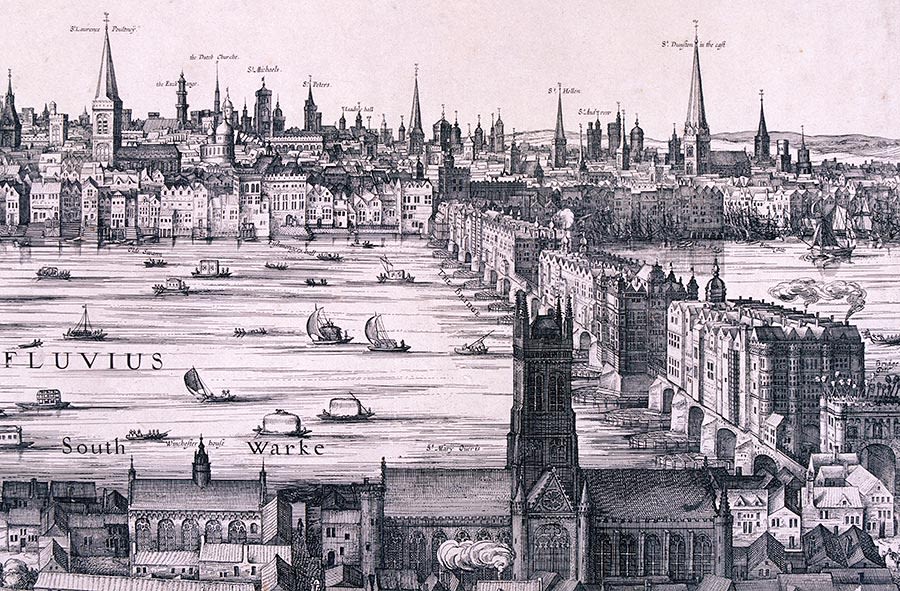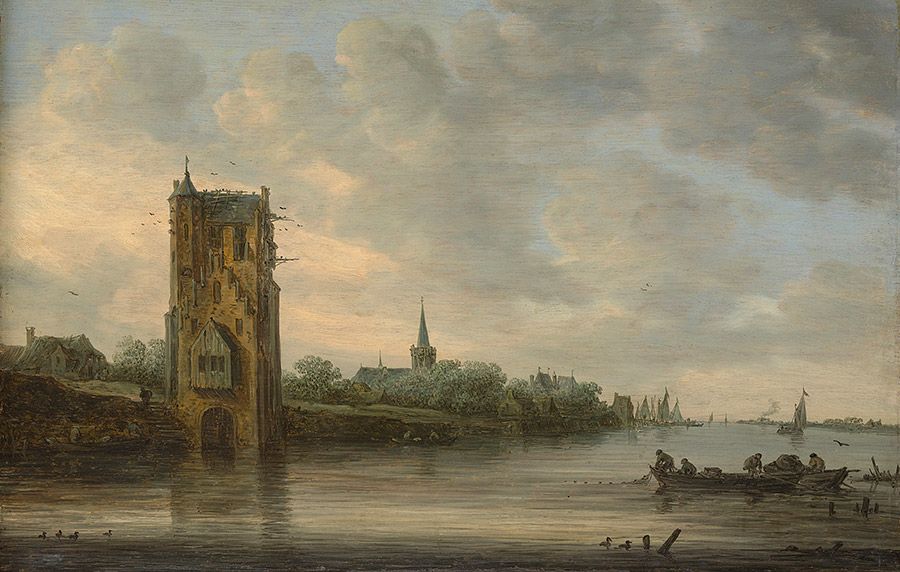OLD LONDON BRIDGE
A 17th-century Dutch masterpiece

Old London Bridge is one of the most popular paintings in the Iveagh Bequest at Kenwood, north London. Painted in 1630, it is the work of the little-known Dutch artist Claude de Jongh (c.1603–1663) and is considered his masterpiece.
London Bridge was begun in 1176 and for centuries was the only stone crossing over the river Thames. Spanning more than 900 feet, it was the longest inhabited bridge in Europe and was considered a wonder of the world.
De Jongh’s masterpiece provides a unique record of both this remarkable structure and the vernacular architecture of the city that would be engulfed in 1666 by the Great Fire of London.
THE BRIDGE
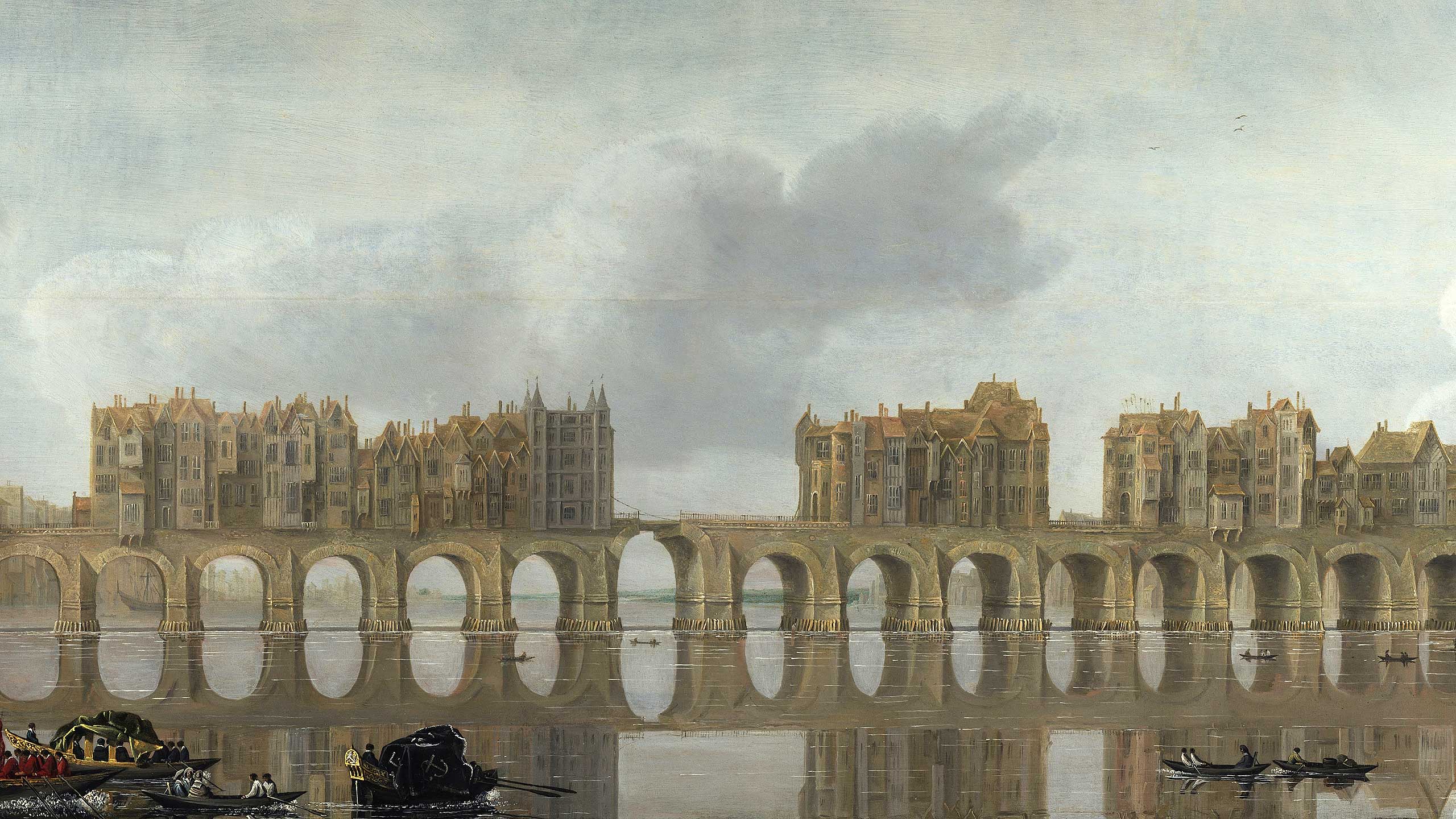
Among manie Famous monuments w[i]t[h]in this realm none Deserveth more to be sett before
the Worlds view than this londen bridge … as by reporte the fame of it is spred through
manie nations
A bridge has spanned the Thames between the City of London and Southwark from the time of the Romans. The earliest bridges were constructed from wood and had to be replaced frequently.
The well-known nursery rhyme ‘London Bridge is falling down’ may have been inspired by a legendary battle for control of the city, which resulted in the destruction of the bridge. In 1014, London and Southwark were occupied by Danes. The Saxon King Aethelred is said to have sailed up the Thames with his ally, Olaf Haraldsson (later King of Norway), to recapture the city. According to a Norse saga, on arriving at London Bridge Olaf and his army tied cables to the piles supporting the bridge and rowed their ships back downstream, shaking the piles until the bridge collapsed.
Between 1077 and 1136 London was ravaged by eight fires, and in 1091 the city was struck by a tornado. Each incident damaged the bridge. Finally, in 1176, the construction of a new stone bridge was begun by Peter the Bridge Master, a member of the clergy and Master of the Brethren of the Bridge of London.
The new bridge took more than 30 years to complete. Its foundations were built by driving wooden stakes into the riverbed and infilling with rubble. The bridge was then erected on piers connected by 19 pointed arches spanning a total of 926 feet (282 metres).
Detail from an engraved panorama of London by Claes Visscher showing the bridge in 1616, with the church of St Mary Overie (now Southwark Cathedral) in the foreground
Detail from an engraved panorama of London by Claes Visscher showing the bridge in 1616, with the church of St Mary Overie (now Southwark Cathedral) in the foreground
This incarnation of London Bridge was slightly downstream from its wooden predecessors and from the site of the bridge which today bears the name. It survived in that position for more than 600 years.
The longest inhabited bridge in Europe, its roadway was lined from the outset with shops and houses. It served as the gateway to the city and was a place of religious pilgrimage and royal pageantry.
Remarkably, London Bridge survived the Great Fire of London in 1666. A previous, smaller fire had destroyed several houses on the north side of the bridge, which provided a firebreak and saved most of the bridge from the flames.
Frost Fair on the Thames, with Old London Bridge in the distance, 1684. (© Yale Center for British Art; public domain)
Frost Fair on the Thames, with Old London Bridge in the distance, 1684. (© Yale Center for British Art; public domain)
However, by the beginning of the 18th century, the medieval London Bridge was dilapidated and was considered old fashioned. The opening of Westminster Bridge further upriver in 1749 highlighted the restrictions and limitations of the ancient structure. Its narrow arches constrained the movement of river traffic and slowed the flow of the water to such an extent that the Thames would often freeze over during very cold winters. In a fast-growing metropolis, the narrow roadway across the medieval bridge also caused congestion for carriages and pedestrians.
Samuel Scott’s painting shows Old London Bridge in 1757, shortly before the houses were removed
Samuel Scott’s painting shows Old London Bridge in 1757, shortly before the houses were removed
In the mid 18th century, work began to remove the shops and houses from the bridge in order to widen the road. But despite the improvements, which also included replacing the two central arches with one larger arch, the changes proved inadequate. In 1824, a new ‘London Bridge’ of five stone arches was finally begun. It was opened seven years later by King William IV and the medieval bridge was at last dismantled.
John Rennie’s new London Bridge, photographed in 1911. The bridge, completed in 1831, was sold in 1968 and moved to Arizona. (© Heritage Image Partnership Ltd / Alamy Stock Photo)
John Rennie’s new London Bridge, photographed in 1911. The bridge, completed in 1831, was sold in 1968 and moved to Arizona. (© Heritage Image Partnership Ltd / Alamy Stock Photo)
The 19th-century London Bridge (famously referred to in TS Eliot’s The Waste Land) survived for little more than a century before it in turn was replaced, in the 1970s, by the present bridge. The 19th-century bridge was sold and re-erected in Arizona.
Unreal City,
Under the brown fog of a winter dawn,
A crowd flowed over London Bridge, so many,
I had not thought death had undone so many.
THE PAINTING
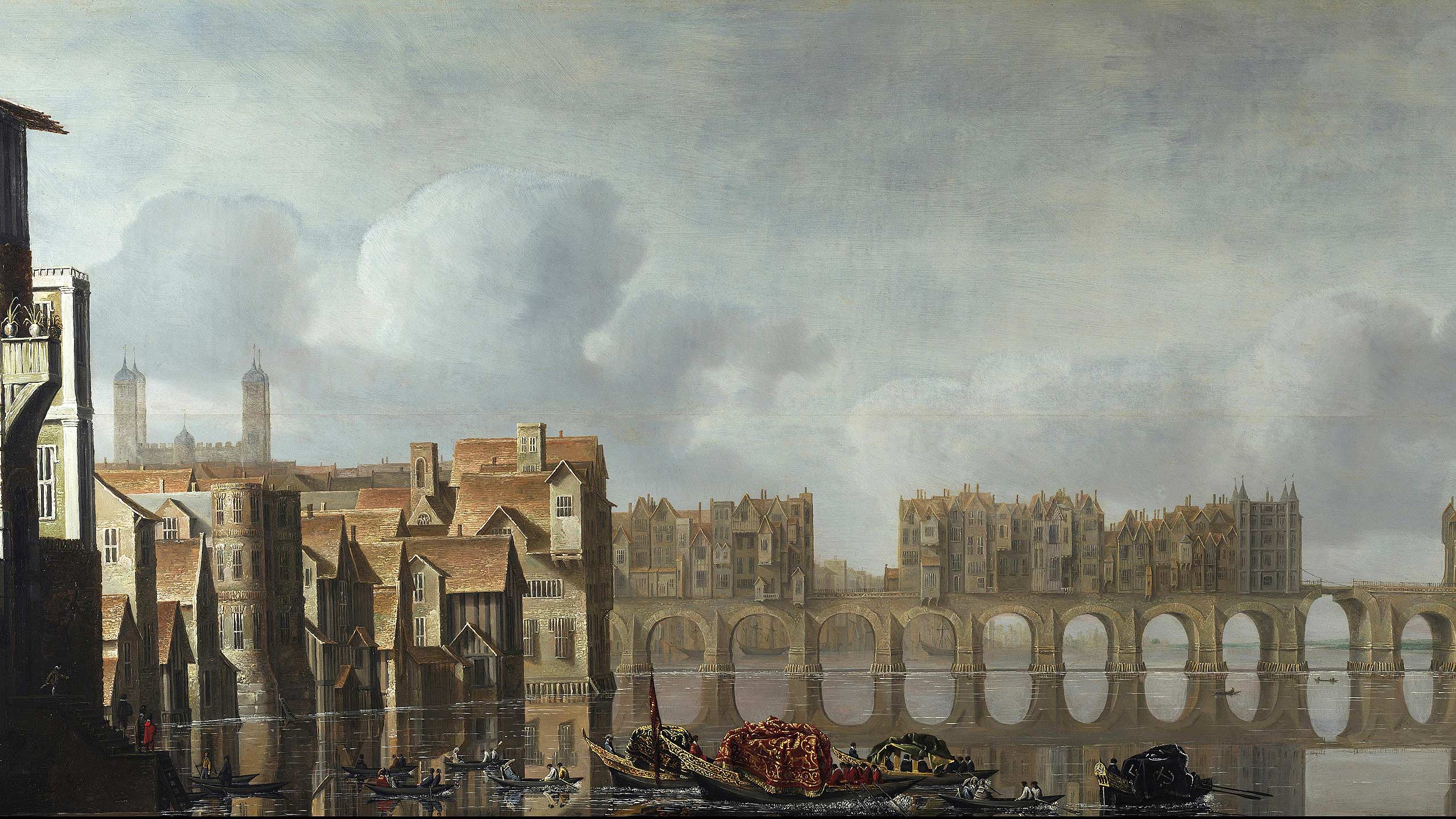
Claude de Jongh visited England at least twice. During a visit between April and May 1627, he made a drawing of London Bridge. The pen and ink sketch is inscribed ‘London the 18 off April 1627’ and was almost certainly made in situ. Following his return to the Dutch Republic in 1630, de Jongh used this drawing as a basis for his painting of the bridge.
De Jongh’s pen, ink and wash sketch of the bridge, made during his visit to London in 1627, now in the Guildhall Library and Art Gallery. (© London Metropolitan Archives)
De Jongh’s pen, ink and wash sketch of the bridge, made during his visit to London in 1627, now in the Guildhall Library and Art Gallery. (© London Metropolitan Archives)
Both the preliminary drawing and the painting show London Bridge from the west. At the time there were no embankments; buildings cluster along the banks of the river and, in some instances, project out into it. De Jongh captures the striking contrast between the wealth of the City of London to the north, with its large stone buildings, and the ramshackle structures of the South Bank, including taverns, inns, gambling houses and theatres. On the bridge itself, shops and houses flank the roadway. To the left, the familiar outline of the Tower of London rises behind the bridge, while on the right is the tower of St Mary Overie (St Mary Over the Water, now called Southwark Cathedral).
The picture’s unusual format – the oak panel on which it is painted is more than three times as long as it is high – may have been suggested by the subject matter, as de Jongh’s preliminary drawing has similarly strange proportions. It is also possible that the painting was commissioned for a specific panelled interior and was intended to fit over a door or mantelpiece. De Jongh painted Old London Bridge following his return to the Dutch Republic, while he was living in Haarlem, a bustling commercial centre. It is plausible that the painting may have been commissioned by a merchant who did business in England.
A view of Haarlem in the 1630s, by Reyer Claesz Suycker. De Jongh was living in Haarlem when he painted Old London Bridge. (Public domain, via Wikimedia Commons)
A view of Haarlem in the 1630s, by Reyer Claesz Suycker. De Jongh was living in Haarlem when he painted Old London Bridge. (Public domain, via Wikimedia Commons)
De Jongh painted at least three other versions of the composition. One, signed and dated 1632, is now in the Yale Center for British Art, Connecticut, while another, painted almost two decades later in 1650, is in the collection of the Victoria and Albert Museum, London. A third version was sold at auction in 2019.
The version of the painting signed and dated 1632. (© Yale Center for British Art, Paul Mellon Fund; public domain)
The version of the painting signed and dated 1632. (© Yale Center for British Art, Paul Mellon Fund; public domain)
This version of the painting, made in 1650, includes a view of a church on a hill on the far right, which does not appear in the earlier drawing or paintings. (© Victoria and Albert Museum, London)
This version of the painting, made in 1650, includes a view of a church on a hill on the far right, which does not appear in the earlier drawing or paintings. (© Victoria and Albert Museum, London)
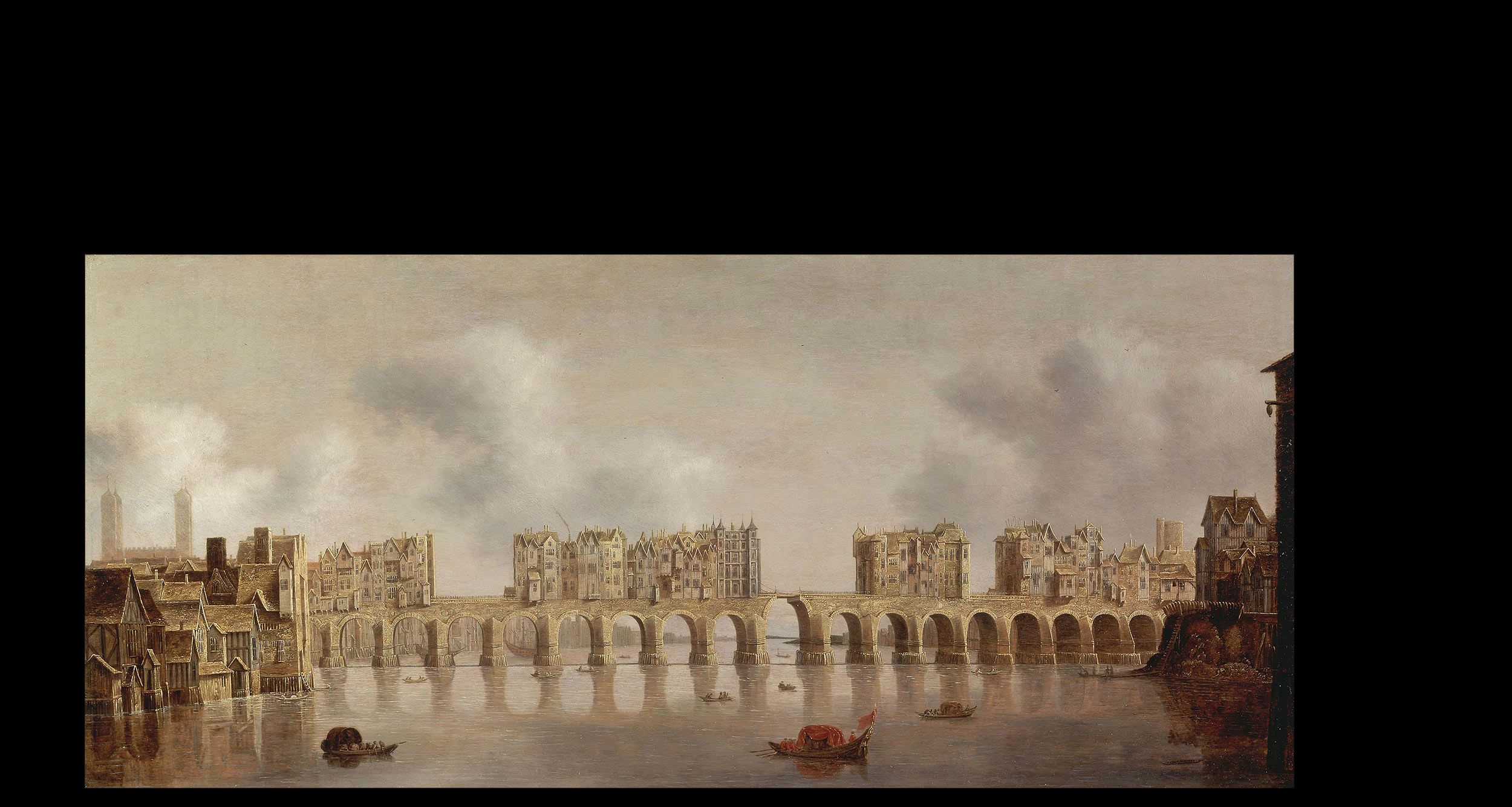
A CLOSER LOOK
Scroll down to zoom in on features of the Kenwood painting in detail and find out more about them.
Funeral procession
In his drawing of London Bridge, Claude de Jongh includes almost no activity on the water itself – only a barrel bobbing in the foreground. In the final painting, however, the artist enlivens the scene with several boats and numerous figures.
Most prominent is the funeral procession departing from the north bank, led by several barges draped in fine cloth. The size of the party suggests the passing of a member of the nobility or a master of a city livery company.
St Magnus the Martyr Church
The tower of St Magnus the Martyr can be seen on the north bank of the river. This church had an important place in the history of London Bridge. It stood at the head of the bridge, and the roadway that gave access to and from the bridge passed through the churchyard, via the west door.
The plaque in the churchyard of St Magnus the Martyr. (© June Green/Alamy Stock Photo)
The plaque in the churchyard of St Magnus the Martyr. (© June Green/Alamy Stock Photo)
The building of bridges was considered an act of piety by the Church and for centuries, London’s citizens made gifts of land and money ‘to God and the Bridge’. Until the Reformation, the buildings on London Bridge included a chapel dedicated to St Thomas Becket, for the use of pilgrims travelling to Canterbury Cathedral to visit Becket’s tomb.
St Magnus the Martyr stood less than 300 metres from the bakery on Pudding Lane where the Great Fire of London began in 1666, and was among the first buildings to be destroyed by the fire. It was subsequently rebuilt by Sir Christopher Wren.
Tower of London
De Jongh includes the distinctive form of the Tower of London in the skyline behind the bridge, although the structure would not have been visible from the viewpoint depicted. It is likely that he included the Tower so prominently because he was painting for a Dutch audience. The inclusion of the famous landmark would have served to definitively identify the view as London Bridge, rather than other inhabited bridges like the Pont-au-Change in Paris or the Ponte Vecchio in Florence.
Houses and shops
The bridge was a vibrant commercial area and one of the city’s four or five main shopping streets. At the peak of the bridge’s prosperity in the 14th century, the bridge wardens received rents from around 140 properties. By the time de Jongh made this painting in 1630, many of the houses had merged and there were only 91 separate dwellings. Originally the houses had only two storeys but they were gradually enlarged, until by the 17th century most had four or five storeys.
When it was first built, there seems to have been a deliberate attempt to attract the most prestigious trades to London Bridge. In the late 14th century shops on the bridge included haberdashers, glovers, cutlers (retailers of knives and cutting implements), bow makers and fletchers (arrow makers). When de Jongh visited London, most shops on the bridge were occupied by haberdashers, as well as cloth merchants and grocers.
Nonsuch House
Completed in 1579, Nonsuch House was a palatial four-storey residence that straddled the centre of the bridge. It is the earliest known prefabricated building, having originally been built in the Netherlands. The building was dismantled and shipped ‘flat pack’ across the North Sea to be reassembled in London, with each timber marked so that the house could be reconstructed correctly. It was rebuilt on the bridge using only wooden pegs, without any carpenter’s nails, mason’s mortar or smith’s iron.
As it sat at the centre of the bridge, with the principal front facing towards Southwark, Nonsuch House was effectively the entrance to the City of London from the south. It was elaborately carved with ornate decorations on its east and west fronts, which overhung the sides of the bridge. Square towers stood at each of the four corners. These were crowned with onion domes, although de Jongh depicts them as spires. The gilded vanes atop the towers could be seen from all parts of the city.
Drawbridge
London Bridge had a drawbridge about 28 feet (8.5 metres) wide, which could be raised twice each day when the tide was high to allow ships to pass through. The drawbridge could also be raised on occasions when London came under attack, as it was in 1381 to prevent entry into the city by Wat Tyler and his rebels during the Peasants’ Revolt.
De Jongh depicts the drawbridge in the centre of the bridge. In reality it was two arches further south, between the sixth and seventh piers from the southern end. De Jongh appears to have taken this artistic liberty in the interests of symmetry.
Southwark Gate and traitors’ heads
At the southern end of London Bridge, close to the riverbank, stands Southwark Gate. De Jongh has depicted the skyline bristling with the severed heads of traitors, displayed on spikes as a warning to citizens and visitors. The first unfortunate person whose head was displayed at Southwark Gate was the Scottish knight William Wallace, executed in 1305. Over the centuries, the heads of many more famous traitors were so displayed, including the rebel Jack Cade, Henry VIII’s former Lord Chancellor Thomas More, Thomas Cromwell and Guy Fawkes.
Maintaining this macabre spectacle was the job of the ‘Keeper of the Heads’. He was responsible for first preserving the heads by parboiling and coating them in tar, and then impaling them for display. After two to three weeks, he removed the weathered skulls from view and discarded them in the Thames.
Bankside theatres
In the extreme right of the painting, two flags are just visible above the skyline of timber houses. These belong to two of the playhouses that occupied the Bankside area of Southwark in the early 17th century, which included the Globe, Swan and Hope theatres.
Reflection
The 19 stone piers that supported London Bridge took up more than 80 per cent of the riverbed, effectively acting like a dam. This caused the Thames to glide slowly at low tide, allowing de Jongh to capture in remarkable detail the reflection of the bridge and surrounding buildings in the glass-like surface of the water.
WHO WAS CLAUDE DE JONGH?

Claude de Jongh was born in the Dutch city of Utrecht around 1603. Among his earliest known works are a number of drawings made in 1625 on what was to be the first of several visits by the artist to England. They include drawings of St Augustine’s Abbey in Canterbury, Kent, and the Thames at Westminster.
De Jongh’s drawing of St Augustine’s Abbey, Canterbury, made in 1625 during the first of his visits to England. (© Collection Centraal Museum, Utrecht)
De Jongh’s drawing of St Augustine’s Abbey, Canterbury, made in 1625 during the first of his visits to England. (© Collection Centraal Museum, Utrecht)
On a second trip in 1627, de Jongh again passed through Kent on his way to London and made further drawings, at Gravesend and Rochester Castle.
De Jongh made his last known visit to England in 1628. His visits to England were probably sketching holidays, as there are no documentary records to suggest that he lived in the country for any extended period. Other works attributed to him suggest that he may have made similar trips to the French cities of Rouen and Lyon at some point in the 1620s.
De Jongh became a member of the Guild of St Luke (the city guild of artists) in Utrecht in 1627, but is known to have been living and working in Haarlem in around 1630 when he painted his first view of Old London Bridge. Haarlem was an important centre in the development of Dutch landscape art at this time. The influence of early Haarlem school painters such as Jan van der Velde (1593–c.1641), Esaias van der Velde (1587–1630) and Jan van Goyen (1596–1656) is evident in the pale grey-brown tonality of de Jongh’s masterpiece, as well as in his use of reflections as a pictorial device. The sharp contrast of light and shade in the buildings suggests he was also familiar with Rembrandt’s landscapes from this period.
The Pelkus Gate near Utrecht, by Haarlem School artist Jan van Goyen, 1646. (© The Metropolitan Museum of Art, New York; gift of Francis Neilson, 1945)
The Pelkus Gate near Utrecht, by Haarlem School artist Jan van Goyen, 1646. (© The Metropolitan Museum of Art, New York; gift of Francis Neilson, 1945)
The paintings and drawings made by de Jongh during his visits to England are among the earliest topographical views of the country. He was also the first of a long line of artists to be captivated by the river Thames and its bridges. A little more than a century after de Jongh painted London Bridge, the great Venetian topographical artist Canaletto made a drawing of the structure, and in 1794 the young JMW Turner captured the bridge as it then appeared, cleared of shops and houses.
Undated drawing of Old London Bridge by Antonio Canaletto, who arrived in London in 1746. (© Trustees of the British Museum)
Undated drawing of Old London Bridge by Antonio Canaletto, who arrived in London in 1746. (© Trustees of the British Museum)
In the late 19th century, artists including Claude Monet and James Abbott McNeill Whistler followed in de Jongh’s artistic footsteps, making numerous paintings and drawings of the Thames.
Claude Monet’s painting of Waterloo Bridge, 1901, is one of many paintings and drawings he made of the Thames. (© National Gallery of Art, Washington DC/Florian Carr Fund; public domain)
Claude Monet’s painting of Waterloo Bridge, 1901, is one of many paintings and drawings he made of the Thames. (© National Gallery of Art, Washington DC/Florian Carr Fund; public domain)
Little is known of the history of de Jongh’s Old London Bridge before Edward Cecil Guinness, 1st Earl of Iveagh (1847–1927), bought it in 1888. When he died, the painting was among the 63 works bequeathed to the nation as part of the Iveagh Bequest, together with Kenwood and the surrounding estate.
Although de Jongh remains a relatively little-known artist, Old London Bridge shows him to have been a talented painter and a pioneer of the topographical landscape. His masterpiece offers a remarkable window onto London of the past and remains one of the most popular paintings at Kenwood.

